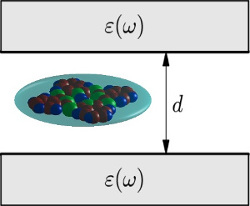Dear guests,
macroscopic bodies build the foundation of all physical experiments. Beamsplitters, mirrors and waveguides in optical experiments, wires and coils for atomic traps are only few examples. In the group quantum optics of macroscopic systems, we are interested in the influence of optical components on quantum mechanical properties of light, which can be used to transport quantum information. Quantum mechanical correlations (entanglement) can be generated by nonlinear processes and destroyed again by absorption.
In the proximity of macroscopic bodies atoms experience a force, which originates from altered quantum mechanical fluctuations of the electromagnetic field. This so called Casimir-Polder force is – besides the Casimir- and van der Waals force – an example of a purely quantum mechanical interaction with no classical equivalent. Such forces act on very short length scales (typically nm for the van der Waals forces and µm for the Casimir-Polder forces) and are thus important for the binding of molecules to each other, to nano-structures and to macroscopic bodies. Our group investigates the influence of geometric and electromagnetic properties of macrocscopic systems on those forces. This work improves the fundamental understanding and opens a wide range of possibilities for the manipulation of atoms and molecules in the proximity of solid surfaces.
Prof. Dr. Stefan Scheel
Head of group


